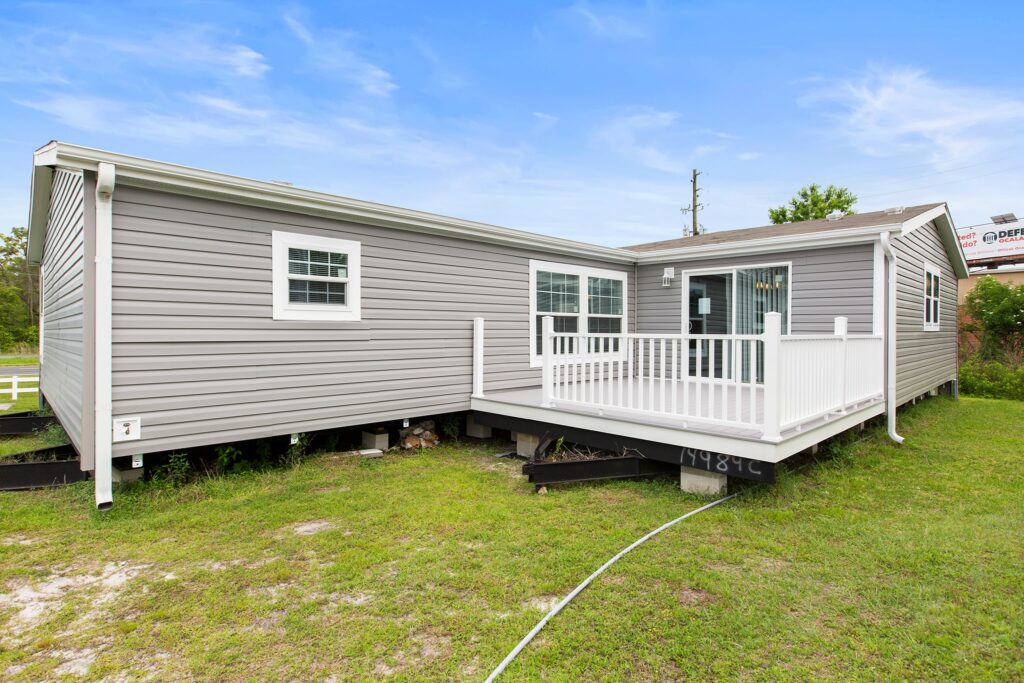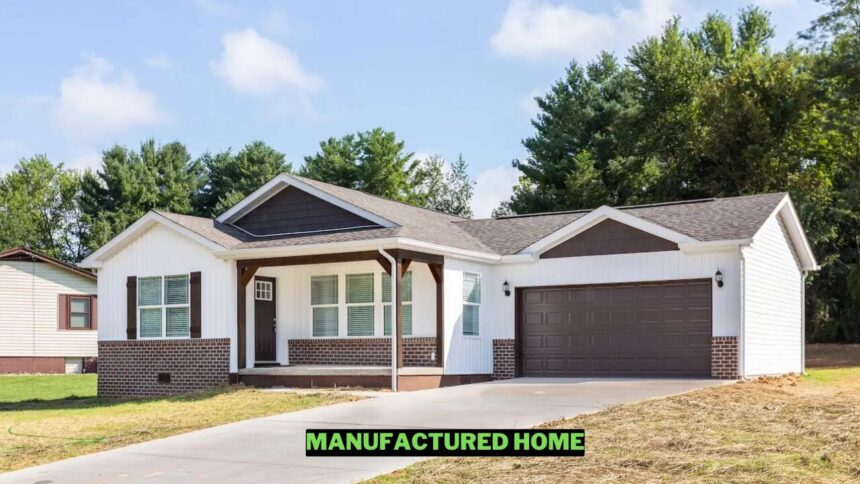The concept of owning a home has always been a cherished part of the American dream. In today’s real estate market, there are a plethora of options available for individuals looking to purchase a home.
These options range from modest condominiums to grand mansions, ensuring that there is a suitable home for every individual. Among the various choices, manufactured homes have emerged as a popular alternative for home buyers in the United States.
These homes are typically priced significantly lower than conventional site-built homes, making them an enticing choice for young families embarking on their homeownership journey or retirees seeking to downsize their living space.
In the past, these dwellings were commonly referred to as mobile homes, but now they are known as manufactured homes.
Despite some similarities, such as being constructed off-site and later assembled on a rectangular chassis instead of a permanent foundation, modern manufactured homes have evolved to offer increased customization options and luxurious features compared to the mobile homes of earlier times.
You Might Also Like:
What Is a Manufactured Home?

Manufactured homes, also known as mobile homes, differ from traditional stick- or site-built homes in terms of construction. Instead of being built on-site, piece by piece, they are constructed in a factory. After the construction process is complete, these homes are transported to the desired location where the homeowner intends to reside.
A manufactured home is a type of dwelling that is built in a factory setting and is subject to specific guidelines set by the U.S. Department of Housing and Urban Development (HUD). These guidelines were implemented on June 15, 1976, to ensure stricter construction standards for mobile homes and other factory-built homes.
A manufactured home is built according to the HUD code, which sets specific requirements for its construction. One key requirement is that these homes are built on a permanent chassis, which includes a base frame with wheels. Additionally, they must have a minimum size of 320 square feet. After being transported to their final destination, the wheels are taken off and the chassis is then positioned on piers, masonry crawl spaces, or a concrete foundation.
Manufactured homes are a viable choice for budget-conscious buyers due to their affordable pricing, shorter construction time, and improved energy efficiency compared to stick-built homes. These homes are typically priced 10% to 35% lower per square foot than traditional homes, thanks to the reduced cost of materials. Despite lingering negative perceptions, research indicates that manufactured homes generally maintain or increase in value over time.
Manufactured Home vs. Mobile Home
A manufactured home, also known as a mobile home, is a type of housing that was produced prior to June 15, 1976. Unlike traditional homes, these houses have the ability to be transported and relocated. Unfortunately, mobile homes gained a negative perception due to their early models, which were often constructed with poor quality and experienced rapid depreciation in value.
Manufactured homes have significantly evolved over the years. Unlike their predecessors, modern manufactured homes are not intended for frequent relocation. They have enhanced structural integrity, ensuring higher levels of safety and comfort. Moreover, manufactured homes now boast a wide range of floorplans and amenities, such as well-equipped kitchens and generous bedrooms.
Manufactured homes, also commonly known as mobile homes, are housing structures that were built after June 15, 1976. These newer mobile homes have officially been categorized as manufactured homes. However, it is important to note that mobile homes constructed prior to this date do not meet the criteria to be classified as manufactured homes, even if improvements or renovations have been done.
Modular Home vs. Manufactured Home
Manufactured homes, also known as modular homes, are constructed in a factory and then transported in sections to the desired location. Once there, these sections are assembled and fixed onto a permanent foundation.
Unlike manufactured homes, modular homes are typically not moved again after installation. While they are not required to meet the same HUD standards as manufactured homes, they must still comply with federal, state, and local building codes that apply to traditional site-built homes.
How to Buy a Manufactured Home
When it comes to purchasing a manufactured home, there are several options available to you. Similar to buying a car, there are specialized retailers that deal with these types of properties, and you can choose between new or used homes.
Financing can be arranged through manufactured home dealers, and you have the opportunity to customize the home with various amenities. The dealer will typically handle the delivery and installation process.
Alternatively, you can enlist the help of a real estate agent to find manufactured homes for sale, or explore listings on manufactured home marketplaces. It is also possible to purchase directly from the owner in certain states.
How Much Does a Manufactured Home Cost?
The price of a manufactured home is determined by several factors. One of these factors is the size of the home, which can vary. You can choose from single-, double-, or triple-wide floor plans, and you have the option to include multiple rooms.
Based on the latest information provided by the U.S. Census Bureau, the average price of a new single-wide manufactured home, which typically ranges from 500 to 1,200 square feet in size, is approximately $80,200. Similarly, the average cost of a new double-wide manufactured home, spanning between 1,000 and 2,200 square feet, is around $155,700.
In order to own a manufactured home, you will also need to purchase or lease the land on which the home is placed. If you choose to rent a spot within a mobile home park, it is your responsibility to pay monthly rent, utilities, and any additional fees for shared amenities.
If you’re considering purchasing a manufactured home, another option is to buy a piece of land separately. The price of the land will vary greatly depending on its location and the amenities nearby, similar to the cost of rent. For instance, the U.S.
Department of Agriculture (USDA) reported that the average cost of an acre of farmland in the U.S. in 2022 was $3,800. However, it’s important to note that plots of land in urban areas are likely to have higher prices compared to rural areas.
How to Buy Property for a Manufactured Home
Before purchasing a property, it is essential to review the local zoning regulations that apply to manufactured homes. These regulations may include restrictions on land use and the size of the home, which could impact your plans to use it for business purposes.
Additionally, when assessing a property, it is important to consider factors such as accessibility, necessary permits, soil quality, and the amount of preparation work needed for the area and foundation.
If you are considering buying a piece of land for permanent residence, you have the option of finding a suitable space in a residential neighborhood. However, if you desire a larger outdoor area, it would be beneficial to consider exploring land options in more secluded locations.
If you require financial assistance for buying a manufactured home, there are two possible options available. The first option is to obtain a loan specifically for the land and another loan specifically for the manufactured home.
However, this can be less convenient since you will need to meet the qualifications for two separate loans and handle two separate payments. The alternative option is to secure a loan that covers both the land and the property together.
Pros and Cons of Manufactured Homes
If you are still unsure about opting for a manufactured home, let’s provide you with a concise overview of the main advantages and disadvantages to help you make an informed decision.
Pros of Manufactured Homes
- Typically more affordable
- Manufactured homes are frequently more affordable compared to homes built on-site. These homes offer the flexibility to be customized according to your specific budget and lifestyle requirements. In the present, it is feasible to purchase a manufactured home that provides the same level of comfort and amenities as a traditional home but at a significantly lower cost.
- Pose efficiency
- A manufactured home refers to a type of housing that can be constructed and set up in a short period of time. The building process of these homes is designed to be efficient and error-free, minimizing any potential damage or delays. Additionally, manufactured homes are known for their high energy efficiency, as they are constructed according to the HUD code, which mandates the inclusion of energy-saving elements.
- They are versatile
- A manufactured home is a suitable option for those looking for a first home, as it offers the flexibility to expand in the future. As your requirements evolve or your family grows, you have the option to add additional modules to your manufactured home. Although most manufactured homes are not designed to be mobile anymore, there is still a possibility of relocating it to a different site in the future.
Cons of Manufactured Homes
- Financing can be difficult to secure
- Manufactured homes vary in their classification as real property, which can affect your ability to obtain a conventional mortgage or loan for purchasing a manufactured home. In such cases, you might be subjected to higher interest rates for financing the purchase of a manufactured home.
- There are location limitations
- A manufactured home does not include the land it is placed on. In order to reside in a manufactured home, you must also obtain a piece of land, which can be either in a community specifically for manufactured homes or a separate lot. This additional requirement results in extra expenses in addition to the cost of the home itself.
- Negative stigma
- Despite significant improvements in terms of safety and aesthetics over the past few decades, manufactured homes and parks still carry a negative association.
Manufactured Home Loan Rates
Manufactured home loans typically have interest rates that are at least one percentage point higher than traditional home loans. The specific rate you qualify for will also be influenced by the type of manufactured home loan you require. However, if you opt for conventional, FHA, VA, or USDA loans, the overall cost may not be significantly different from that of a site-built home.
A manufactured home refers to a dwelling that is constructed off-site and then transported to its final location. In order to purchase a manufactured home, individuals have the option to secure financing through a personal loan. It is important to note that the interest rates associated with personal loans can vary significantly. While the most favorable personal loan rates can rival
When it comes to manufactured home loans, your credit score and loan-to-value (LTV) ratio play a crucial role in determining the interest rate. This applies to all types of home loans. It’s worth noting that older manufactured home loans may attract higher interest rates compared to newer ones.
The Bottom Line
A manufactured home is a cost-effective housing option that offers more value for your investment. It provides the opportunity to personalize your property and enjoy a larger living space that may have been unaffordable otherwise.
This type of home is particularly popular among retirees and empty-nesters. However, it is important to note that manufactured homes still face the misconception of being temporary or trailer-like.
Unlike traditional homes, they do not appreciate in value as much, making them less suitable for quick real estate investments. Additionally, it is important to consider that there may be limited financing options available for purchasing or constructing a manufactured home.





